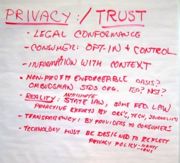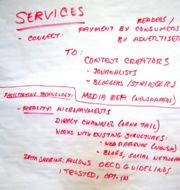Difference between revisions of "Blueprint-bullets"
From IVP Wiki
(→Report back from the advertising breakout group) |
|||
| (10 intermediate revisions by the same user not shown) | |||
| Line 1: | Line 1: | ||
| − | + | '''Participants in "Blueprinting the Information Valet Economy" broke into three groups on Thurs., Dec. 4, 2008 to develop a list of key values, features -- and unanswered questions -- about the development and operation of a shared-user network for privacy, advertising and information commerce. The breakout groups each met for over an hour at the Donald W. Reynolds Journalism Institute at the Missouri School of Journalism. The three groups considered:'''<ul><ul> | |
| − | < | + | *'''Business model, legal, corporate, marketing, ownership''' |
| − | + | *'''Content and syndication ''' | |
| − | == | + | *'''Advertising, privacy, demographics, identity''' |
| + | <br>''''Here are highlights of their ''report backs:'' '''<br> | ||
| + | </ul></ul> | ||
| + | ==1. Report from the business models/legal/corp/marketing, ownership breakout group== | ||
| + | [[Image:Ivp-conference-room.jpg|300px|thumb|right|Break-out meeting room [http://www.flickr.com/photos/mediagiraffe/sets/72157609502122909/ VIEW OTHER RJI ROOMS]]] | ||
| + | [[Image:Blueprint-listening.jpg|450px|thumb|right|Listening in the Fred Smith Forum [http://www.flickr.com/photos/33134655@N06/sets/72157610817325064/ VIEW MORE PHOTOS]]] | ||
| + | [[Image:Stites-obremski-SMALL.jpg|300px|thumb|right|One-on-one-discussions]] | ||
===Content creators=== | ===Content creators=== | ||
| Line 43: | Line 49: | ||
*Self-policing organization (one instead of millions) | *Self-policing organization (one instead of millions) | ||
*Capabilities for better regulation than government | *Capabilities for better regulation than government | ||
| − | *Ability to generate new ideas and better ways of doing things | + | *Ability to generate new ideas and better ways of doing things |
| − | ==Report back from the content / syndication breakout group== | + | ==2. Report back from the content / syndication breakout group== |
| − | + | [[Image:Blueprint-content-breakout.jpg|400px|thumb|right|Click image to view fullsize]] | |
| − | |||
| − | |||
| − | |||
| − | |||
| − | ===Defining the InfoValet (Howard' | + | ===Defining the InfoValet (Howard Saltz' definition)=== |
''A centralized place in which news providers could exchange with each other and with users things about value, relationships, reputation, information and even money.''<br>Examples: | ''A centralized place in which news providers could exchange with each other and with users things about value, relationships, reputation, information and even money.''<br>Examples: | ||
*A common registration platform – instead of many registration sites, one place where they register which gives them access to many different sites and registration information as value to all the sites that participate. | *A common registration platform – instead of many registration sites, one place where they register which gives them access to many different sites and registration information as value to all the sites that participate. | ||
| − | *A PayPal like setup where if they pay for low-rate content they don’t have to enter their credit card over and over again. Simplicity. | + | *A PayPal-like setup where if they pay for low-rate content they don’t have to enter their credit card over and over again. Simplicity. |
*Common place to sign up for text message or emails. | *Common place to sign up for text message or emails. | ||
*Common set of ethical standards. | *Common set of ethical standards. | ||
*Information exchange on the backend among participants | *Information exchange on the backend among participants | ||
| − | ==Report back from the advertising/demographics/privacy/ID breakout group== | + | ===Key issues raised=== |
| + | *Figure out a definition of content | ||
| + | *Movement of news as process rather than product | ||
| + | *How do you have transactions around it? | ||
| + | *Defining the role of journalists and journalism | ||
| + | |||
| + | ==3. Report back from the advertising/demographics/privacy/ID breakout group== | ||
===Privacy/trust=== | ===Privacy/trust=== | ||
| − | *Legal conformance (may | + | [[Image:Privacy-trust-poster.jpg|180px|thumb|right|privacy-trust issues]] |
| + | *Legal conformance (may requires laws that don’t exist) | ||
*Bottom-up approach – consumer has opt in and control over the information they reveal – how it is used. With context. | *Bottom-up approach – consumer has opt in and control over the information they reveal – how it is used. With context. | ||
*How? Some type of non-profit entity, maybe a standards organization, an enforceable ombudsman that speaks for the consumer. ISO? NST? | *How? Some type of non-profit entity, maybe a standards organization, an enforceable ombudsman that speaks for the consumer. ISO? NST? | ||
| Line 70: | Line 79: | ||
*Transparency as much as possible with consumers. Trust fundamental to making system work. | *Transparency as much as possible with consumers. Trust fundamental to making system work. | ||
*Technology has to reflect all these principles of privacy policy. | *Technology has to reflect all these principles of privacy policy. | ||
| + | |||
| + | [[Image:Service-poster.jpg|180px|thumb|left|Service issues]] | ||
===Services=== | ===Services=== | ||
| − | *Connect payment by advertisers to the content consumers and to the media rep/the newspaper channel collecting the information. | + | |
| − | *Tech realities to include: | + | * -- Connect payment by advertisers to the content consumers and to the media rep/the newspaper channel collecting the information. |
| − | *Micropayments | + | * -- Tech realities to include: |
| − | *Direct channels to groups | + | * -- Micropayments |
| − | *Needs to work with existing systems (blogs, social networks) | + | * -- Direct channels to groups |
| − | *Has to be trusted, opt-in system | + | * -- Needs to work with existing systems (blogs, social networks) |
| + | * -- Has to be trusted, opt-in system | ||
Latest revision as of 15:40, 7 December 2008
Participants in "Blueprinting the Information Valet Economy" broke into three groups on Thurs., Dec. 4, 2008 to develop a list of key values, features -- and unanswered questions -- about the development and operation of a shared-user network for privacy, advertising and information commerce. The breakout groups each met for over an hour at the Donald W. Reynolds Journalism Institute at the Missouri School of Journalism. The three groups considered:
- Business model, legal, corporate, marketing, ownership
- Content and syndication
- Advertising, privacy, demographics, identity
'Here are highlights of their report backs:
Contents
1. Report from the business models/legal/corp/marketing, ownership breakout group

Break-out meeting room VIEW OTHER RJI ROOMS

Listening in the Fred Smith Forum VIEW MORE PHOTOS
Content creators
- Focused reach
- Reach tiny niches economically
- Reach the long tail
- Make money on other peoples information (share value)
- A business that works
- Ability to influence development
Content consumers
- Convenience, security, privacy, monetizing relationships
- Content they like
- Content not available elsewhere
- Saving time and money
- Frictionless
- Ability to influence how this develops
- Scale ability to be compensated as creator as well as consumer
Commerce players
- Access to trusted nodes (papers, local brands, retailers)
- Monetize content through better value
- Access to content to more effectively market
- Unique channels to consumers
- Increases advertising efficiency
Aggregators of content
- Cuts down on acquisition cost of customers
- Antidote to Google
- Scale for important pieces of their business (e.g. OpenID)
- New customers for platforms
- Differential pricing
Educators
- Access to different genres of communication
- Access to new business models
- Narrowcasting, instead of broadcast mode
Regulators (beneficiary not stakeholder?)
- Self-policing organization (one instead of millions)
- Capabilities for better regulation than government
- Ability to generate new ideas and better ways of doing things
2. Report back from the content / syndication breakout group
Defining the InfoValet (Howard Saltz' definition)
A centralized place in which news providers could exchange with each other and with users things about value, relationships, reputation, information and even money.
Examples:
- A common registration platform – instead of many registration sites, one place where they register which gives them access to many different sites and registration information as value to all the sites that participate.
- A PayPal-like setup where if they pay for low-rate content they don’t have to enter their credit card over and over again. Simplicity.
- Common place to sign up for text message or emails.
- Common set of ethical standards.
- Information exchange on the backend among participants
Key issues raised
- Figure out a definition of content
- Movement of news as process rather than product
- How do you have transactions around it?
- Defining the role of journalists and journalism
3. Report back from the advertising/demographics/privacy/ID breakout group
Privacy/trust
- Legal conformance (may requires laws that don’t exist)
- Bottom-up approach – consumer has opt in and control over the information they reveal – how it is used. With context.
- How? Some type of non-profit entity, maybe a standards organization, an enforceable ombudsman that speaks for the consumer. ISO? NST?
- Reality – state law will move faster than federal law. Federal will emerge from it.
- Should be proactive efforts now by organizations and technologists and journalists to socialize what is being said so laws don’t get created that cause more harm than good.
- Transparency as much as possible with consumers. Trust fundamental to making system work.
- Technology has to reflect all these principles of privacy policy.
Services
- -- Connect payment by advertisers to the content consumers and to the media rep/the newspaper channel collecting the information.
- -- Tech realities to include:
- -- Micropayments
- -- Direct channels to groups
- -- Needs to work with existing systems (blogs, social networks)
- -- Has to be trusted, opt-in system



